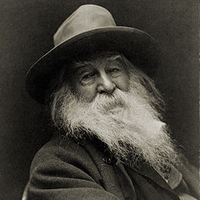Crossing Brooklyn Ferry by Walt Whitman: Analysis
The poem is based on Whitman’s ideas on the external forward movement of all things, through life, death and rebirth, and his ideas of an interrelationship of all people that transcends time and place. He reaches back to acknowledge the past and look forward to greet the wonderful future. The ferry, the people that cross on it, and the rushing water beneath, serve for Whitman as mystical symbols of an everlasting and unified flow of humanity from the present into the future.

Walt Whitman (1819-1892)
The scene is of New York harbor and it is a very realistic one. But the poet's meditations expand it into a timeless locate that is part of a dreamlike vision. Whitman looks ahead from his own time as well as back from a future moment in the company of future people. The busy sights and sounds could be the bustle of any place and any time: their symbolic meaning transcends the harbor and represents the sharing of all life's experiences. Time and distance never isolate people in the philosophy of Whitman's poetry; the poet always expresses his belief in a unified chain of humanity, unbroken and extending forward and backward in time. Several images in the poem suggest notions of a life and death cycle. The images with their movement toward sunset suggest the human journey from birth to death and the unity of generations in an endless process. From the great spiritual reservoir the individual is given individuality. The individual possesses 'individuality', yet is bound in a unity of common spiritual origin.
Crossing Brooklyn Ferry" is a kind of dramatic monologue. The title of the poem introduces the temporal and spatial figures that play such important parts in the poem. The figurative ferry and the equally figurative flood tide carry him "far away" to that purely poetic place from which his highly metaphorical meditation on time and space, doubt and faith, issues. The panorama of the city and the river as seen from the moving ferry gradually comes to coexist with the narrator's imagined sight of those people of the future who will occupy the place he occupies now. The curiosity of the poet's eyes extends from the physical the imagined, from the perceptual to the conceptual. The persona crosses from shore to shore, from tangible to intangible, sight to feeling, object to subject, and more importantly, from present to future as Whitman attempts to go beyond the doubts, questions and fragmentation of modern experience caused by various psychological, political, and spiritual uncertainties. He crosses to the future as teacher, prophet, and comrade. He offers the consoling vision of a "well-joined scheme" in which everything and everyone have their part to play, whether "great or small" in the making of a soul that seems to resemble more closely the Hindu `atma' than the individualized Christian spirit. The idea of transcendence is here extended to that of transcending over time to make one's being connected to those of the people of the future.
The style of Whitman is both minutely particular and broadly general. It involves the merging, or contrasting, of the particular and the general, of private revelation and public declaration, of the self-reliant individual and democracy's 'mass man'. This is a poem of his obsession with the democratic poetics. Whitman avoids conventional poetry's narrowly defined rhythmical patterns and he explores the possibilities of more fluid and organic rhythm based upon repetition of various kinds of words and syntactical structures. Another striking feature of his style is the manipulation of tense. Speaker and reader merge by means of a trick of tense. The future becomes present and present becomes past. But then, becoming free of verb tenses and of psychic tensions, the speaker posits the reality of the eternal moment of time itself or rather of timelessness. Whitman's transcendentalist narrator penetrates the "appearances" of the world of phenomena in order to discover the truth that binds each and all together in one "simple, compact, well joined scheme." The scheme is the cosmic design, the house builder's version of Emerson's more abstract Over-soul against the exclusion, exile and helplessness of modern man. Whitman holds out the possibility of a slimed experience, a return to the wholeness of the protecting, all-satisfying "solution" of the cosmic womb. The mood throughout the poem is one of joyous celebration. The speaker's faith is firm, the questions that at first seem to express doubt turn out to be rhetorical. The poem's meaning lies within the poet's power of imagination in the realm of the ecstatic and the prophetic.
Site this Page!
Shrestha, Roma. "Crossing Brooklyn Ferry by Walt Whitman: Analysis." BachelorandMaster, 23 Mar. 2018, bachelorandmaster.com/britishandamericanpoetry/crossing-brooklyn-ferry-analysis.html.
Related Topics
The World Below the Brine: Analysis
When Lilacs Last in the Dooryard Bloom'd: Analysis
Crossing Brooklyn Ferry: Summary
Song of Myself (Section 1: Summary & Analysis)
Song of Myself (Section 6: Summary & Analysis)
Song of Myself (Section 11: Summary & Analysis)
Song of Myself (Section 52: Summary & Analysis)
 |
bachelorandmaster.com |